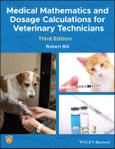This user-friendly guide to medical mathematics helps veterinary technician students develop the math skills required before going into the practice setting.
- New workbook format allows readers to practice problems right inside the book
- Covers math fundamentals, metric and non-metric conversions, dosing and concentration, IV drug infusion, prescriptions, and doctors' orders
- Offers step-by-step instructions for performing calculations
- Newly expanded to include calculation of constant rate infusions, dilutions, compounding, and anesthesia applications
- Features a full answer key and images from the book in PowerPoint for instructors on a companion website
Table of Contents
Contents
About the Companion Website ix
Section I Review of Math Fundamentals 1
1 Math Fundamentals: Self-assessment 3
Self-assessment Exercises 3
2 Review of Key Medical Math Fundamentals: Decimals 11
2.1 Relative Values of Decimal Numbers 11
2.2 Properly Communicating Decimal Numbers 12
2.3 The Rules for the Use of Zero in Decimal Numbers 13
2.4 Comparing Decimals - Which Number Is Larger? 14
2.5 A Quick Guide to Using Scientific Notation 15
2.6 Tips for Adding and Subtracting Decimal Numbers 17
2.7 Tips for Multiplying Decimal Numbers 18
2.8 Tips for Dividing Decimal Numbers 19
2.9 Accurately Rounding Decimal Numbers 22
2.10 Chapter 2 Practice Problems 23
3 Review of Key Math Fundamentals: Fractions 27
3.1 Fundamentals of Working with Medical Math Fractions 27
3.2 Working with Improper Fractions, Proper Fractions, and Mixed Numbers 28
3.3 Equivalent Fractions in Medical Math 29
3.4 Simplifying or Reducing Fractions 30
3.5 Adding Fractions in Medical Math 31
3.6 Subtracting Fractions in Medical Math 33
3.7 Multiplying Fractions in Medical Math 34
3.8 Dividing Fractions in Medical Math 37
3.9 Conversion between Fractions and Decimals 39
3.10 Rounding Fractions in Medical Math 41
3.11 Chapter 3 Practice Problems 42
4 Review of Key Math Fundamentals: Percentages 47
4.1 Conversion of Percentages to Fractions 47
4.2 Conversion between Percentages and Decimal Numbers 48
4.3 Conversion of Fractions to Percentages 49
4.4 Finding Percentages of a Whole 49
4.5 Subtracting or Adding the Percentage Fraction of the Whole 50
4.6 Determining Percentages Represented by the Fractional Component 52
4.7 Chapter 4 Practice Problems 53
5 Review of Key Math Fundamentals: Finding the Unknown X 57
5.1 Analyzing the Problem and Setting up the Equation 57
5.2 Addition: Moving Numbers to the Other Side of the Equation 58
5.3 Subtraction: Moving Negative Numbers or a Negative UnknownX 59
5.4 Finding the Unknown X in Multiplication Problems 62
5.5 When the Unknown X is in the Denominator 67
5.6 Finding the Unknown X in Division Problems 70
5.7 Unknown X Involving Division of Fractions 71
5.8 Chapter 5 Practice Problems 74
Section II Understanding Units and Labels 77
6 Measurements Used in Veterinary Medicine 79
6.1 Metric Units: The Basics 79
6.2 Metric Units of Weight and Mass 80
6.3 Metric Units of Volume 82
6.4 Metric Units of Length 83
6.5 Metric Units of Concentration and Density 84
6.6 Nonmetric Units: Household, Apothecary, and Avoirdupois Units 85
6.7 Conversion between Quantities of Volume and Mass: Special Cases 87
6.8 Converting Between Units: The Proportion and Cancel-Out Methods 87
6.8.1 Using the Proportion Method 88
6.8.2 Using the Cancel-out Method 91
6.9 Estimating the Answer: Does Your Answer Make Sense? 93
6.10 Chapter 6 Practice Problems 96
7 Understanding Drug Orders and Drug Labels 99
7.1 The Dosage Regimen 99
7.1.1 The Dosage Regimen: Doses and Dosages 100
7.1.2 The Dosage Regimen: The Route of Administration 100
7.1.3 The Dosage Regimen: The Dose Interval 102
7.2 The Dosage Form 102
7.3 The Best Practices for Writing Drug Orders 103
7.3.1 Handling Unclear Drug Orders 104
7.4 Understanding the Drug Label: The Drug Names 104
7.5 Understanding the Drug Label: Concentrations and Dosage Forms 107
7.6 Understanding the Drug Label: Regulatory Label Information 109
7.6.1 Controlled Substances and Prescription Labeling 110
7.6.2 Prescription, Legend, and Over-The-Counter Label Indicators 110
7.7 Understanding the Drug Label: Hazards, Storage, and Expiration Dates 110
7.7.1 Storage Information on the Label 111
7.7.2 Expiration Dates 111
7.8 Chapter 7 Practice Problems 112
Section III Dose Calculations 115
8 Basic Dose Calculations 117
8.1 The Basic Steps in Dose Calculation 117
8.2 Converting the Animal’s Weight into the Units Needed to Calculate the Dose 119
8.3 Determining the Dose for the Patient 120
8.4 Determining the Amount of Dose Forms Needed per Dose 122
8.5 Determining the Number of Dosage Forms Needed to Complete the Dosage Regimen 125
8.5.1 The Most Common Mistake Made when Determining the Total Number of Units to Be Dispensed 126
8.6 Determining the Cost for Dispensed Medication 128
8.7 Using a Syringe with Liquid Dosage Formulations 129
8.7.1 Syringes in Veterinary Medicine 130
8.7.2 Measuring Fluid within the Syringe 131
8.8 Chapter 8 Practice Problems 132
9 Intravenous Infusion Calculations 137
9.1 Performing IV Infusions and the Use of IV Administration Sets 137
9.2 The Basics of Setting IV Fluid Rate Using the Drip Chamber 138
9.3 Setting the IV Fluid Rate: Constant Rate Infusions (CRI) 142
9.4 Calculating Infusion Rates when Adding Drugs to IV Fluids 144
9.5 Calculating Standard IV Fluid Rates 147
9.6 Calculating IV Fluid Rate Stop Times 151
9.7 Chapter 9 Practice Problems 153
Section IV Other Calculations Used in Veterinary Medicine 157
10 Ratios, Proportions, and Dilutions 159
10.1 Ratios and Proportions 159
10.2 The Basics of Making a Dilution 161
10.3 Making Serial Dilutions 162
10.4 Calculating Diluent Needed to Deliver a Specific Dose or Drug Concentration 163
10.5 Calculating Dilutions Using the V1 × C1 = V2 × C2 Formula 164
10.6 Diluting Percent Solutions 166
10.7 Diluting Solutions Expressed as Ratios 167
10.8 Making Dilutions with Mixed Types of Concentrations 168
10.9 Chapter 10 Practice Problems 169
11 Additional Calculations Used by Veterinary Professionals 171
11.1 Mean, Median, Mode, and Range 171
11.2 Converting between Fahrenheit and Celsius 175
11.3 Roman Numerals 179
11.4 Chapter 11 Practice Problems 181
Appendix: Answers to Practice Problems 183
Index 223








